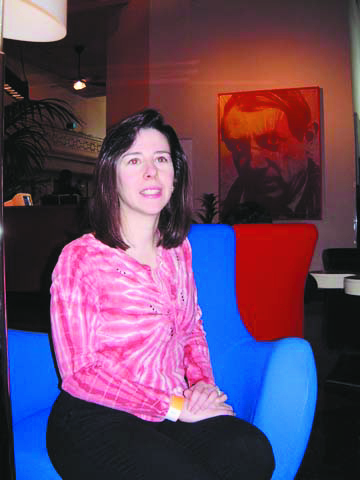Christopher Chambers Interviews Gail Rothman
(Republication of a dArt magazine Summer 2003 article.)

Young, attractive, and successful executive at an assets management firm in New York, Gail Rothman, is also an enthusiastic collector of art. She started collecting in 1998 and has already acquired over one hundred pieces, but she still humbly labels herself a neophyte. She approaches her “vice” passionately and hopes to follow in the steps of her two idols, Dr. Alfred C. Barnes and herbert Vogel. Barnes, a very wealthy man, collected according to his personal intuitions regardless of current trends, and was proven by time to have been astute in his selections. And she emulates Herb Vogel because he amassed a legendary collection on his postman’s salary, demonstrating that a great collection can be assembled on a limited budget.
Christopher Chambers: Do you collect current fine art exclusively?
Gail Rothman: My collecting criteria is that the piece must have been made from 1990 onwards, the artist still has to be alive, and the proceeds – these are primary sales – either has to benefit the artist or a charity that the artist has designated. I am currently not doing anything in the secondary market, so in a sense I am acting as a patron.
CC: Who do you buy from?
GR: Benefit auctions, artists directly, or through a gallery – a dealer.
CC: It seems like you really launched into collecting with a vengeance. What precipitated this? What was the impetus?
GR: A lot of white walls in my apartment. I had been a member of museum groups at the Museum of Modern Art and the Guggenheim, and I said, “Ooh, you know maybe it’s a little embarrassing for people to come over to my house and there’s no art.” I think you get to a certain point in your life and you decide, “I’d rather have something that’s an original piece.”
CC: Do you bargain with the dealers?
GR: I buy art like I buy clothes. If I see something that I like, but I can’t choose the color, then I get more than one. As with anything, if you are buying more than one, or if you are potentially going to be a customer that comes back, you get discounts. I have to work for my art vice. You try to be smart shopper.
CC: Do you have relationships with particular dealers, or do you pretty much scour the market?
GR: A combination of both. I I have a good relationship in Frankfort with L.A. Gallery. In New York with Derek Eller Gallery and Paul Morris Gallery. In California: Mark Moore Gallery.
CC: Where is your collection housed?
GR: Several places right now, depending on the kindness of friends and family.
CC: Do you fraternize with other collectors?
GR: I do fraternize with some collectors. I’d like to fraternize with more. It seems to be a small conspiracy to keep collectors away from each other. When you go to a gallery the’re always very discreet and very mysterious about who the other collectors are, so you don’t run into them too often, Slowly but surely you build up your collector’s network.
CC: Have you collected specific artists in depth?
GR: Yes, I have to say I love all my artists, but I have particularly strong crush now on Oliver Boberg (Constructed reality photos. Shows with Paul Morris, New York and L.A. Gallery Frankfort). I have several pieces of Thomas Scheibitz (figurative German painter, represented in New York by Tanya Bonakder Gallery), and Michael Reafshneider (an American, he makes abstract, heavy impasto, colorful paintings. Shows with Mark Moore in Los Angeles), Giles Lyon (young American abstract painter represented by Feigen Contemporary in New York) Whiting Tennis (innovative young American collage/painter with Derek Eller gallery, New York).
CC: How much do you usually spend for a young artist?
GR: Smaller works under $3000.
CC: Who do you listen to?
GR: I listen to my internal voice. If I love a piece it doesn’t really matter what anyone says. I listen to dealers when they have an artist that they have an artist that they think might fit my taste, and I ask other artists what they think. I have bought some pieces by the artists I just mentioned that people have pooh-poohed and then allof a sudden the artist’s career started expanding two years later and everyone said, “Oh, I can’t believe you got that artist, you were such a visionary!” And I’m thinking, “Don’t they remember what they told me two years ago? They thought it was a piece of crap.”
